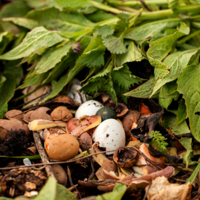Composting—the act of recycling organic matter, from food to lawn clippings—keeps biodegradable materials out of the waste stream while adding beneficial nutrients to the soil. Food, which occupies the largest space-by-volume in landfills, can break down in your backyard to help plants grow, increase moisture retention in the ground, and lower our carbon footprint by reducing emissions associated with hauling trash to landfills and the methane produced therein.
For all these reasons, Pela put together a 10-step beginners’ guide to composting that will get you started turning your food scraps and yard waste into “black gold.”
Left over food and yard waste make up more than 30% of residential trash, despite being biodegradable and beneficial to soil and plants. Composting works by speeding up the natural decay process. While all the organic matter that we throw away will decompose, items in a landfill are packed too tightly together for sufficient airflow to break down. That leads to anaerobic decomposition, which creates significant amounts of methane gas. Methane gas is more than 25 times as powerful as carbon dioxide when it comes to trapping greenhouse gases in the Earth’s atmosphere.
By providing ideal conditions for decomposing organisms to thrive, home composting is faster than traditional hands-off methods and leaves behind nutrient-rich soil that can help fruits, vegetables, flowers, and trees to grow. And unlike artificial or natural fertilizers, backyard compost is free, plentiful, and comes without any additional packaging or chemicals. The process involves separating compostable materials from other garbage and then aerating them in oxygen-rich containers or piles that are turned, watered, and finally added to garden beds or around any number of plants.
Composting can be achieved with the help of worms, black soldier fly larvae, fenced-in piles in your yard, or in rotating tumblers from your local hardware store. Those without space for compost can save food scraps in bins under the sink or in the freezer to be donated to a local community garden. Whether you live in the city or country, a house or apartment, and with or without a backyard, keep reading to discover how you can get started composting at home.
![]()
.

